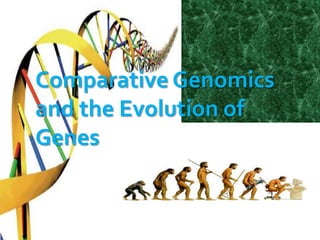Comparative genomics presentation
•Télécharger en tant que PPTX, PDF•
4 j'aime•5,007 vues
PowerPoint for BI 520-01 Spring 2013
Signaler
Partager
Signaler
Partager

Recommandé
Recommandé
Contenu connexe
Tendances
Tendances (20)
Single nucleotide polymorphisms (sn ps), haplotypes,

Single nucleotide polymorphisms (sn ps), haplotypes,
Gene mapping | Genetic map | Physical Map | DNA Data Analysis (upgraded)

Gene mapping | Genetic map | Physical Map | DNA Data Analysis (upgraded)
Biochemical and molecular markers for characterization

Biochemical and molecular markers for characterization
Systems biology & Approaches of genomics and proteomics

Systems biology & Approaches of genomics and proteomics
En vedette
En vedette (20)
Similaire à Comparative genomics presentation
Similaire à Comparative genomics presentation (20)
Utility of transcriptome sequencing for phylogenetic

Utility of transcriptome sequencing for phylogenetic
Phylogeny of Bacterial and Archaeal Genomes Using Conserved Genes: Supertrees...

Phylogeny of Bacterial and Archaeal Genomes Using Conserved Genes: Supertrees...
Evolutionary Genetics by: Kim Jim F. Raborar, RN, MAEd(ue)

Evolutionary Genetics by: Kim Jim F. Raborar, RN, MAEd(ue)
Molecular basis of evolution and softwares used in phylogenetic tree contruction

Molecular basis of evolution and softwares used in phylogenetic tree contruction
Plus de Emmanuel Aguon
Plus de Emmanuel Aguon (9)
NGLA presentation EV 511 Spr 2014: Nothern Guam Lens Aquifer Professor John J...

NGLA presentation EV 511 Spr 2014: Nothern Guam Lens Aquifer Professor John J...
Lecture 3 -the diversity of genomes and the tree of life

Lecture 3 -the diversity of genomes and the tree of life
Comparative genomics presentation
- 1. Comparative Genomics and the Evolution of Genes
- 2. Evolution of Genes and Genomes on the Drosophila phylogeny Based on 12 way comparison
- 3. Phylogenetic Tree of Drosophila
- 7. It is named by analogy with the rapidly- expanding, quasi-random firing pattern of a shotgun. The technique was developed in the 1970s by double Nobel prize laureate Frederick Sanger.
- 8. Craig Venter
- 10. W = dN/ds dN (non synonymous) dS (synonymous) Examined the ratio of non-synonymous W=d to synonymous divergence to explain distribution
- 11. • A major question in evolutionary biology is how important tinkering with promoter sequences is to evolutionary change, for example, the changes that have occurred in the human lineage after separating from chimps. Are evolution in promoter or regulatory regions more important than changes in coding sequences over such time frames? A key reason for the importance of promoters is the potential to incorporate endocrine and environmental signals into changes in gene expression[1]: A great variety of changes in the extracellular or intracellular environment[2] may have impact on gene expression, depending on the exact configuration of a given promoter [2]: the combination and arrangement of specific DNA sequences that constitute the promoter defines the exact groups of proteins that can be bound to the promoter, at a given time [3].
- 13. • Demonstrated the ability to place every one of these genomic comparisons on a phylogeny with a taxon separation that is ideal for asking a wealth of questions about evolutionary patterns and processes. • The use of multi-species orthology “provides” especially convincing evidence in support of particular gene models, not only for protein-coding genes, but also for miRNA and other ncRNA genes.
- 14. The methodology and principles are absolutely general and they are applicable to any genome. The genomes of these species provide an excellent model for studying how conserved functions are maintained in the face of sequence divergence. These genome sequences provide an unprecedented dataset to contrast genome structure, genome content, and evolutionary dynamics across the well-defined phylogeny of the sequenced species
- 15. • Species D. willistoni doesn’t appear to have genes to make proteins containing selenium – proteins that researches had thought were common to all animals. • analysis suggests that “some” gene families expand of contract at a rate of 0.0012 gains and losses per gene per million years or roughly one fixed gene gain/ loss across the genome every 60,000 yr. • Number of structural changes and rearrangements is much larger, for example, there are several different rearrangements of genes in the Hox cluster found in these Drosophila species
- 16. Brosius J, Erfle M, et al. (1985). "Spacing of the -10 and -35 regions in the TAC promoter - effect on its in vivo activity". Journal of Biological Chemistry 260 (6): 3539 –3541. Celniker SE, Drewell RA (2007). "Chromatin looping mediates boundary element promoter interactions". Bioessays 29 (1): 7–10 Vlahopoulos S, Zoumpourlis VC (2004). "JNK: a key modulator of intracellular signaling". Biochemistry (Mosc) 69 (8): 844–54. http://en.wikipedia.org/wiki/Promoter_%28biology%29 Your mom
